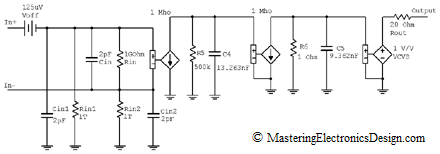MasteringElectronicsDesign.com:Build an Op Amp SPICE Model from Its Datasheet – Part 1, Part 2, and Part 3 of this article show how to create a behavioral model of an operational amplifier based on the following parameters found in the datasheet: Input and output resistance, input capacitance, DC gain, offset voltage and gain bandwidth product. As an example I chose Analog Devices’ ADA4004 and built its behavioral model step by step. Figure 1 shows the model as we left off at the end of part 3.
Figure 1
Let’s continue building this model with some more parameters.





